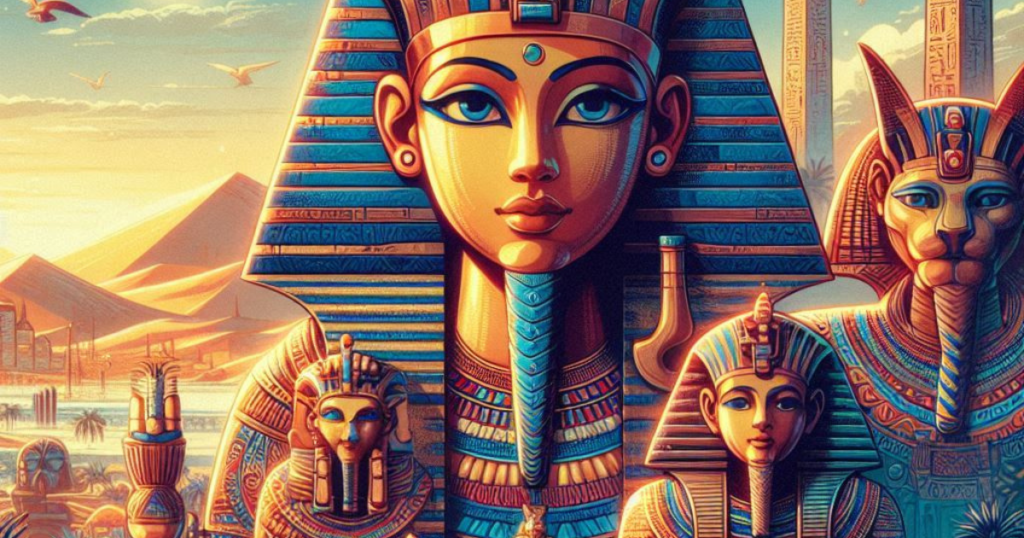The history of the Egyptian Old Kingdom is a tale of remarkable achievements, incredible architectural feats, and a flourishing civilization that laid the groundwork for much of ancient Egypt’s future greatness. Spanning from approximately 2686 to 2181 BCE, this period, also known as the “Age of the Pyramids,” witnessed the construction of some of the most iconic structures in human history and the development of a centralized state that influenced countless generations.

The Rise of the Old Kingdom
The history of the Egyptian Old Kingdom began with the establishment of the Third Dynasty by King Djoser around 2686 BCE. Djoser’s reign marked the beginning of a new era in ancient Egyptian history, characterized by political stability and significant advancements in various fields. Under Djoser’s rule, Egypt saw the construction of the Step Pyramid at Saqqara, designed by the architect Imhotep. This pyramid was not only a monumental achievement in architecture but also a symbol of the pharaoh’s divine authority.
The early pharaohs of the Old Kingdom were able to consolidate their power and unify Upper and Lower Egypt, creating a centralized government that controlled vast resources. This unification allowed for the development of a highly organized society, with a complex bureaucracy that managed agriculture, trade, and labor.
Architectural Marvels
The history of the Egyptian Old Kingdom is most famously associated with the construction of the pyramids, which remain some of the most enduring symbols of ancient Egypt. The Fourth Dynasty, particularly under the rule of Pharaoh Sneferu, saw significant advancements in pyramid construction techniques. Sneferu built several pyramids, including the Bent Pyramid and the Red Pyramid, which served as precursors to the Great Pyramid at Giza.
It was during the reign of Sneferu’s successor, Khufu (also known as Cheops), that the Great Pyramid of Giza was constructed. This colossal structure, standing at 481 feet tall, was the tallest man-made structure in the world for over 3,800 years. The precision and engineering skills required to build such a monument are a testament to the capabilities of the ancient Egyptians. The pyramids were not merely tombs but also symbols of the pharaohs’ divine power and their connection to the gods.
Society and Culture
The history of the Egyptian Old Kingdom is also notable for the development of a sophisticated society and culture. The centralized government allowed for the efficient collection of taxes and the organization of large-scale building projects. The state controlled all aspects of life, from the distribution of food to the construction of temples and monuments.
Religion played a central role in the lives of the ancient Egyptians. The pharaoh was considered a living god, the intermediary between the gods and the people. This belief in the divine nature of the pharaoh reinforced the authority of the central government and justified the immense resources devoted to the construction of the pyramids and other religious structures.
Art and writing flourished during the Old Kingdom. The development of hieroglyphics, a complex system of writing that combined logographic and alphabetic elements, allowed for the recording of religious texts, administrative records, and literary works. Art from this period, often found in tombs and temples, depicted the gods, daily life, and the achievements of the pharaohs. These artworks were not only decorative but also held religious significance, ensuring the pharaoh’s safe passage to the afterlife.
Economy and Trade
The history of the Egyptian Old Kingdom also highlights the importance of a stable economy and extensive trade networks. The Nile River, with its predictable flooding and fertile banks, provided the basis for a thriving agricultural economy. The ancient Egyptians developed advanced irrigation techniques to maximize crop yields, ensuring a surplus of food that could support a large population and workforce.
Trade was an essential aspect of the Old Kingdom’s economy. Egypt traded with neighboring regions, such as Nubia to the south, the Levant to the northeast, and the eastern Mediterranean. Goods such as gold, copper, cedarwood, and precious stones were exchanged, facilitating cultural and technological exchanges that enriched Egyptian society.
Decline and Legacy
Despite its many achievements, the history of the Egyptian Old Kingdom also includes a period of decline. By the end of the Sixth Dynasty, around 2181 BCE, the centralized power of the pharaohs began to wane. Several factors contributed to this decline, including climatic changes that led to famine, economic difficulties, and political fragmentation. The once-strong central government weakened, and local governors, known as nomarchs, gained more power, leading to internal strife and a breakdown in the unity of the state.
The end of the Old Kingdom marked the beginning of the First Intermediate Period, a time of political instability and decentralization. However, the legacy of the Old Kingdom endured. The architectural, artistic, and administrative achievements of this period set the foundation for the future greatness of ancient Egypt. The pyramids, in particular, remain a symbol of the ingenuity and skill of the ancient Egyptians and continue to inspire awe and admiration to this day.
Conclusion
The history of the Egyptian Old Kingdom is a fascinating and complex narrative of human achievement, cultural development, and the rise and fall of a great civilization. From the construction of the pyramids to the establishment of a centralized state, the Old Kingdom laid the groundwork for much of what we associate with ancient Egypt today. Its legacy lives on in the monumental structures that still stand, the art and writings that have been preserved, and the lasting impact on subsequent generations. As we continue to explore and understand this remarkable period, we gain a deeper appreciation for the ingenuity and resilience of the ancient Egyptians.